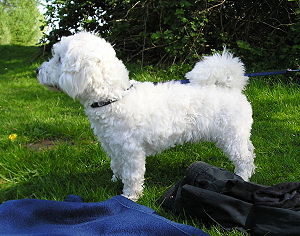Bolonka Franzuska
| Bolonka Franzuska | ||
|---|---|---|
|
|
||
| Not from the FCI recognized | ||
| Origin : | ||
| Alternative names: |
Franzuskaya Bolonka, Bolonka franzuska |
|
| Withers height: |
20 to 26 cm |
|
| List of domestic dogs | ||
The Bolonka franzuska ( Russian Французская болонка ) is not from the FCI recognized dog breed from Russia.
Origin and history
The name of the breed means French lap dog (franzuskaja = French, Bolonka = lap dog, French bichon ). Since the Renaissance , the Bolognese- type lapdogs have enjoyed great popularity and admiration in royal houses. Due to the close ties between the French and Russian nobility , the lapdogs of French ladies spread to tsarist Russia . Even Catherine the Great loved and adored these miniature dogs. She owned a few copies during her reign at the Romanov court .
After the October Revolution of 1917, trade relations broke off and the Soviet Union was isolated. Breeders there developed the Bolonka Franzuska from the French breeding animals existing in the country due to a lack of imports from the country of origin and inbreeding .
The export of a Bolonka Franzuska was very strictly regulated and yet a few breeders in the GDR managed to get into possession of one of the Bolonka Franzuska through diplomatic channels. From 1980 Bolonka Franzuska from Russia were also exported to the GDR and continued under this breed name in the Association of Allotment Gardeners, Settlers and Small Animal Breeders (VKSK). It became one of the most popular dwarf dog breeds in the GDR, until the fall of the Wall, 2,500 puppies were registered.
In 1982 the first dog of this breed, a Russian bitch named "Julia", was introduced into the FRG and entered as a Bolognese in the stud book of the Association of German Small Dog Breeders. The original Russian papers identified the Bolonka Franzuska breed .
In 1985 the BI-Lexicon dog breeds, a standard work on the subject in the GDR, stated that the Bolonka Franzuska certainly goes back to the Bichon Frisé and thought about the further development of the breed. Two ways are presented: the return to the original breed (i.e. in the context there Bichon Frisé) or the recognition as an independent breed.
In 1990, according to the current presentation of the then stud bookkeeper in the VKSK, the dogs from the stud book of the VKSK were taken over into the Bolognese breed . According to the Association of German Small Dog Breeders (VK), the basis of the decision for mass takeover was the fact that in Russia it would never have been doubted that the Bolonka Franzuska were Bolognese. This view had been officially confirmed to the Secretary General of the FCI by the competent authorities in Moscow.
From a color variant of the Bolonka Franzuska, the Bolonka Zwetna was bred in the Soviet Union , which is recognized as a breed in Russia.
description
The Bolonka Franzuska is very similar to the Bichon Frisé , but differs from it in several details. It reaches a shoulder height of 20–26 cm. Very graceful, square-built dog with long wavy to curly hair that is always white. The head is rounded and turns into a short, pointed snout with a clear stop. The ears are small and close to the head. The tail is carried rolled over the back on the side.
Individual evidence
- ^ A b Verband Deutscher Kleinhundezüchter eV: Bolognese retrieved on July 27, 2009
- ↑ a b Hans-Joachim Swarovsky: BI-Lexicon dog breeds . 2nd Edition. VEB Bibliographisches Institut, Leipzig 1985, p. 108 .
